Rancho Cañada Floodplain Restoration Project
PROJECT UPDATE, MARCH 2023
The Rancho Canada Floodplain Project is moving towards producing final designs and obtaining necessary permits for construction with a target start date for construction in 2024. The project team is also in the process of applying for funding from several state and federal grant programs.
Permits and approvals include a Section 401 Water Quality Certification and Waste Discharge Requirement administered by the Regional Water Quality Control Board, which will also ensure that the project complies with the California Environmental Quality Act (CEQA). In January 2023 the Park District submitted a notification to the U.S. Army Corps of Engineers, along with many supporting documents, which leads to a review under the Endangered Species Act by both the U.S. Fish and Wildlife Service and National Marine Fisheries Service. In addition to federal agency approval, the project requires an agreement with the State Department of Fish and Wildlife over changes to the river. Lastly, there are analyses and filings related to historic preservation and cultural resources. The project team does not anticipate delays with permitting due to the broad input received during the planning and design process.
The project team is applying to both federal and state grant programs to fund the nearly $25 million cost of construction. There are several promising grant programs that are focused on habitat restoration for threatened and endangered fish and amphibians, as well as, restoring natural processes and building a more resilient watershed. The restoration team feels this project is a perfect fit for these grant programs.
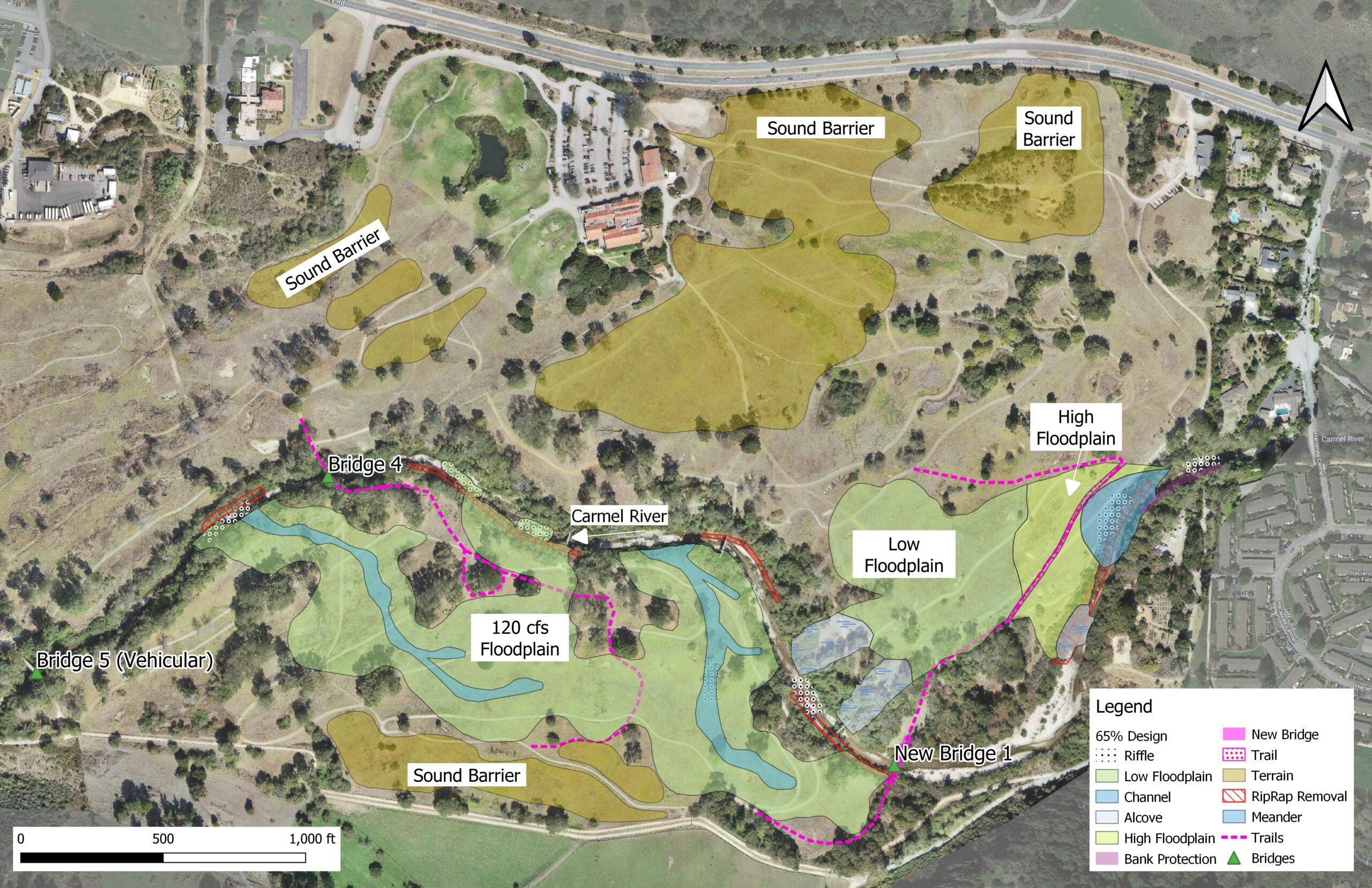
Project Showing Trails Using Bridge #4
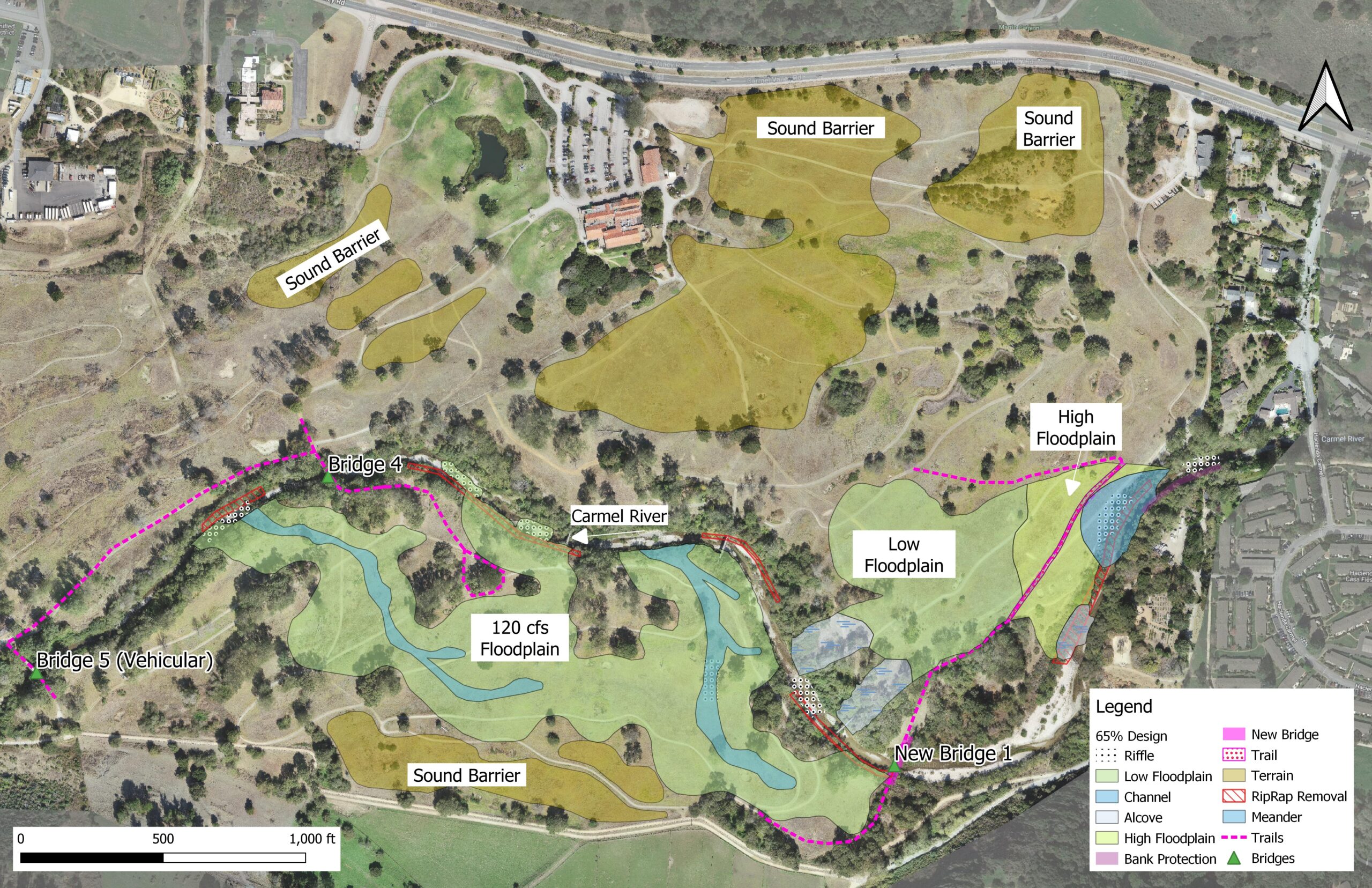
Project assuming the acquisition of Bridge #5.
******
Monterey Peninsula Regional Park District (District) in collaboration with numerous federal, state, and local government agencies and non-profits is beginning the process to restore migration and spawning habitat for steelhead at a new location in the Carmel River watershed. The project site is on a portion of the former Rancho Cañada Golf Club property that was conveyed to the District in 2018 by the Trust for Public Land. The site is approximately 185 acres in size and spans both banks of the Carmel River. The overall goal of the project is to restore and enhance floodplain connectivity and channel processes that will foster sustainable riparian and salmonid habitat along the Carmel River, while being compatible with current and future public access at the site.
An initial outreach meeting was held on the evening of March 9, 2022. A recording of the meeting can be found here.
To receive project updates, sign up for our mailing list here.
Project Description

Monterey Peninsula Regional Park District (District) in collaboration with numerous federal, state, and local government agencies and non-profits is
beginning the process to restore migration and spawning habitat for steelhead (Oncorhynchus mykiss) at a new location in the Carmel River watershed. The project site is on a portion of the former Rancho Cañada Golf Club property that was conveyed to the District in 2018 by the Trust for Public Land. The former golf course is approximately 185 acres in size and spans both banks of the Carmel River. The project would entail excavation of a floodplain features on about 40 acres of the site that is closest to the river and construction of a new pedestrian bridge.
A natural floodplain is vital habitat for to the survival of salmonid fish, as it serves as a nursery and rearing area to grow and mature before returning to the ocean. Such habitat, which is flooded in the wet season and typically supports robust riparian vegetation, provides far more food for young-of-the-year fish than the main part of the river. The floodplain also provides a slow-water refuge during high flow events and can also help recharge the groundwater and reduce flooding in adjacent areas.
The Carmel River watershed contains over one hundred stream miles of high-quality spawning grounds, but virtually no floodplain. As a result, the overall goal of the Rancho Cañada Floodplain Restoration Project is to restore and enhance floodplain connectivity and channel processes that will foster sustainable riparian and salmonid habitat along the Carmel River, while being compatible with current and future public access to park lands. The project implements the recommendations of the Steelhead Recovery Plan, issued by the National Oceanic and Atmospheric Administration’s National Marine Fisheries Service (NOAA Fisheries). The project will also strive to accommodate the existing public trails on the property and will consider other public access amenities that are compatible with habitat protection. Secondary potential benefits of the project are the enhancement of public access to the river for wildlife viewing, education, and non-motorized recreation (subject to subsequent District Planning and Policy).
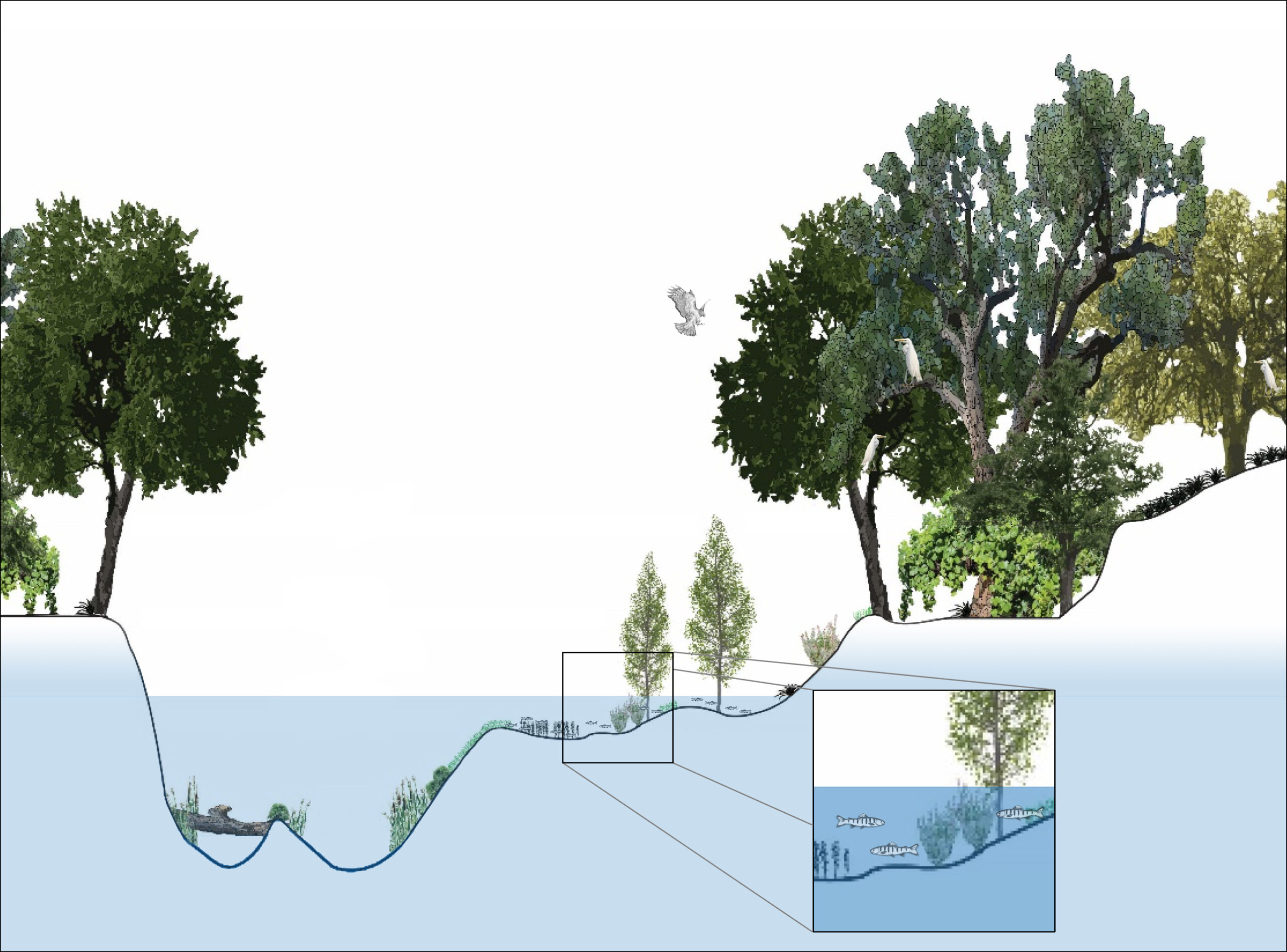
Illustration of inundated floodplains and fish rearing
Goals and Objectives
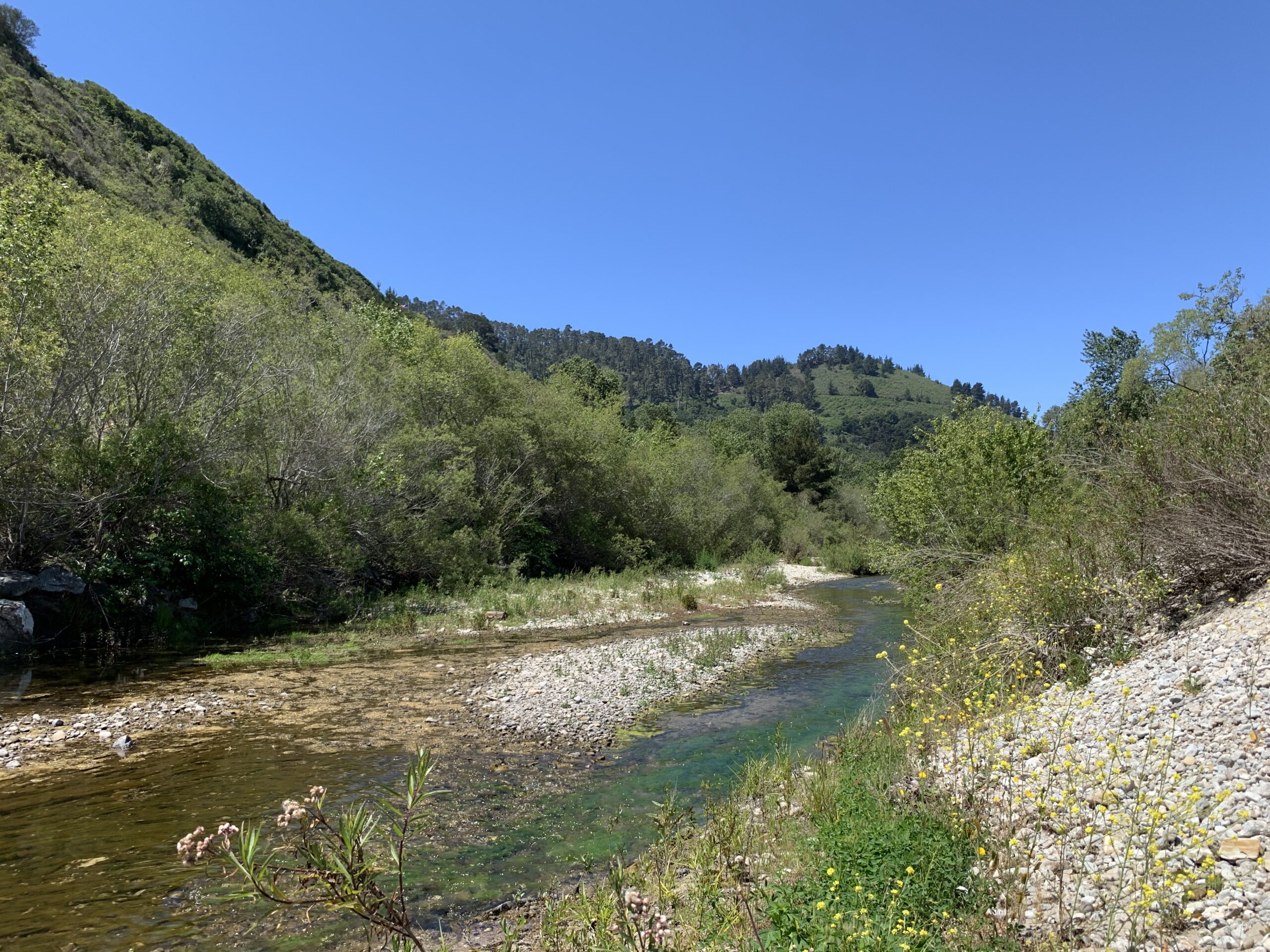
In 2018, a Technical Advisory Committee (TAC), consisting of numerous federal, state, and local government stakeholders was formed in collaboration with the District, California Coastal Conservancy, and Trout Unlimited for the project. The TAC drafted a vision for the project as well as goals that were based on a review of the geomorphic, hydraulic, and biological context of the site. The main goals for the project include: restoring and enhancing floodplain and channel processes in the Carmel River (at the Rancho Cañada Unit of Palo Corona Regional Park) to foster sustainable riparian and salmonid habitat consistent with District recreational access and trail needs and restoring floodplain and floodway function, while accommodating appropriate recreational uses and ensuring that the project will not increase flood water elevations.
Project Contacts
Katrina Harrison
McBain Associates, Applied River Sciences
Water Resources Engineer
katrina (at) mcbainassociates.com
Rachel Couch
State Coastal Conservancy
Project Manager
rachel.couch (at) scc.ca.gov
Jake Smith
Monterey Peninsula Regional Park District
Planning & Conservation Program Manager
jsmith (at) mprpd.org
To receive project updates, sign up for our mailing list here.
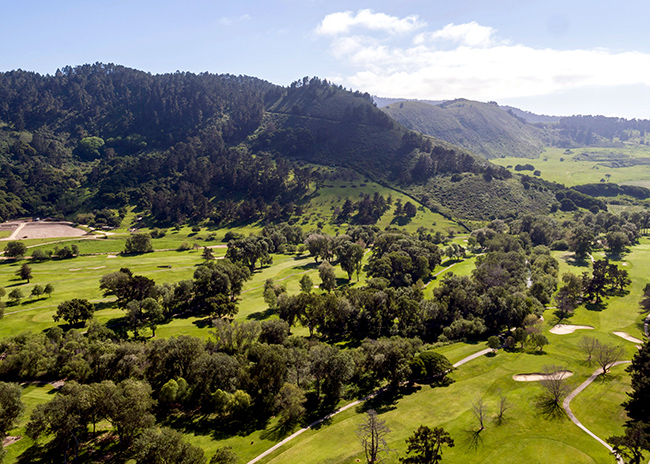
Central Coast News
- Press Release: Coastal Conservancy Awards over $40 million for coastal access, restoration, and climate resilienceOakland, CA (4/18/2024) – Today, the Board of the State Coastal Conservancy approved grants totaling over $40 million for coastal access, restoration, and climate resilience. Among the grants awarded today are: A grant of up to $6,000,000 to Humboldt County Resource Conservation District to undertake the North Coast Wildfire Resilience Planning and Implementation Grant Program, which […] (Read more on Press Release: Coastal...)
- Sea Otter Recovery Grants RFP Now Open!The California State Coastal Conservancy announces the availability of grants to public agencies, tribes and nonprofit organizations for projects that facilitate the recovery of the southern sea otter along California’s coasts. The California Sea Otter Fund is one of the state’s tax check-off funds that allows taxpayers to voluntarily contribute to the recovery of California’s […] (Read more on Sea Otter Recovery...)
- Coastal Conservancy Awards Grants for Coastal Access, Restoration, and Climate Resilience2/15/2024 – Today, the Board of the State Coastal Conservancy authorized a number of grants to restore, protect, and expand access to the California coast. Grants approved included: A grant of an amount not to exceed $35,000,000 to The Nature Conservancy to complete permitting and implement the first phase of the Ormond Beach Restoration Public Access […] (Read more on Coastal Conservancy Awards...)
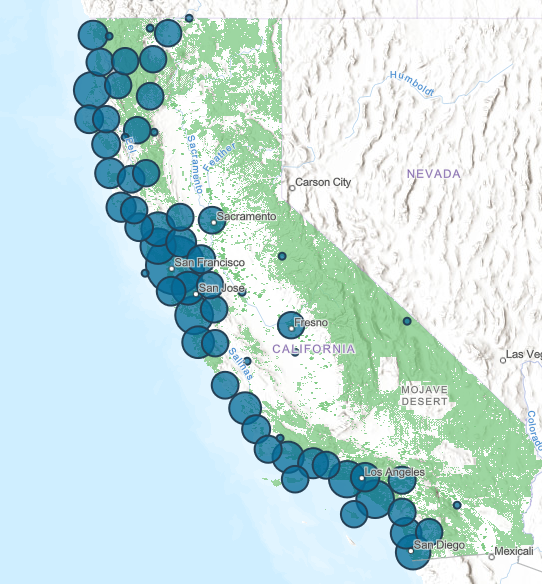
 Help Save Sea Otters at Tax Time
Help Save Sea Otters at Tax Time

